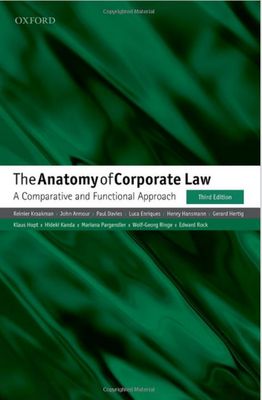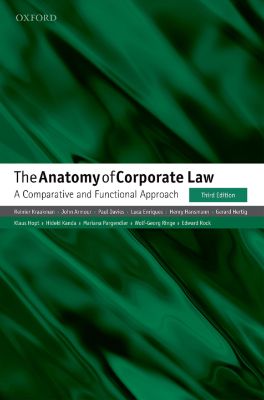The Anatomy of Corporate Law

Lýsing:
This is the long-awaited third edition of this highly regarded comparative overview of corporate law. This edition has been comprehensively revised and updated to reflect the profound changes in corporate law and governance practices that have taken place since the previous edition. These include numerous regulatory changes following the financial crisis of 2007-09 and the changing landscape of governance, especially in the US, with the ever more central role of institutional investors as (active) owners of corporations.
The geographic scope of the coverage has been broadened to include an important emerging economy, Brazil. In addition, the book now incorporates analysis of the burgeoning use of corporate law to protect the interests of "external constituencies" without any contractual relationship to a company, in an attempt to tackle broader social and economic problems. The authors start from the premise that corporations (or companies) in all jurisdictions share the same key legal attributes: legal personality, limited liability, delegated management, transferable shares, and investor ownership.
Businesses using the corporate form give rise to three basic types of agency problems: those between managers and shareholders as a class; controlling shareholders and minority shareholders; and shareholders as a class and other corporate constituencies, such as corporate creditors and employees. After identifying the common set of legal strategies used to address these agency problems and discussing their interaction with enforcement institutions, The Anatomy of Corporate Law illustrates how a number of core jurisdictions around the world deploy such strategies.
In so doing, the book highlights the many commonalities across jurisdictions and reflects on the reasons why they may differ on specific issues. The analysis covers the basic governance structure of the corporation, including the powers of the board of directors and the shareholder meeting, both when management and when a dominant shareholder is in control. It then analyses the role of corporate law in shaping labor relationships, protection of external stakeholders, relationships with creditors, related-party transactions, fundamental corporate actions such as mergers and charter amendments, takeovers, and the regulation of capital markets.
Annað
- Höfundar: Reinier Kraakman, John Armour, Paul Davies, Luca Enriques, Henry Hansmann, Gerard Hertig, Klaus Hopt
- Útgáfa:3
- Útgáfudagur: 2017-01-19
- Hægt að prenta út 2 bls.
- Hægt að afrita 2 bls.
- Format:ePub
- ISBN 13: 9780191059544
- Print ISBN: 9780198724315
- ISBN 10: 0191059544
Efnisyfirlit
- Title Page
- Copyright Page
- Contents
- List of Authors
- 1. What Is Corporate Law?
- 1.1 Introduction
- 1.2 What Is a Corporation?
- 1.2.1 Legal personality
- 1.2.2 Limited liability
- 1.2.3 Transferable shares
- 1.2.4 Delegated management with a board structure
- 1.2.5 Investor ownership
- 1.3 Sources of Corporate Law
- 1.3.1 Special and partial corporate forms
- 1.3.2 Other bodies of law
- 1.4 Law versus Contract in Corporate Affairs
- 1.4.1 Mandatory laws versus default provisions
- 1.4.2 The benefits of legal rules
- 1.4.3 Choice of legal regime
- 1.5 What Is the Goal of Corporate Law?
- 1.6 What Forces Shape Corporate Law?
- 2. Agency Problems and Legal Strategies
- 2.1 Three Agency Problems
- 2.2 Legal Strategies for Reducing Agency Costs
- 2.2.1 Rules and standards
- 2.2.2 Setting the terms of entry and exit
- 2.2.3 Trusteeship and reward
- 2.2.4 Selection and removal
- 2.2.5 Initiation and ratification
- 2.2.6 Ex post and ex ante strategies
- 2.3 Disclosure
- 2.4 Compliance and Enforcement
- 2.4.1 Enforcement and intervention
- 2.4.2 Initiators of enforcement
- 2.4.3 Penalties
- 2.5 Legal Strategies in Corporate Context
- 2.6 Systematic Differences
- 3. The Basic Governance Structure: The Interests of Shareholders as a Class
- 3.1 Delegated Management and Corporate Boards
- 3.2 Appointment and Decision Rights
- 3.2.1 Appointing directors
- 3.2.2 Removing directors
- 3.2.3 Decision rights
- 3.2.4 Shareholder coordination
- 3.3 Agent Incentives
- 3.3.1 The trusteeship strategy: Independent directors
- 3.3.2 The reward strategy: Executive compensation
- 3.4 Legal Constraints and Affiliation Rights
- 3.4.1 The constraints strategy
- 3.4.2 Corporate governance-related disclosure
- 3.5 Explaining Jurisdictional Variation
- 4. The Basic Governance Structure: Minority Shareholders and Non-Shareholder Constituencies
- 4.1 Protecting Minority Shareholders
- 4.1.1 Shareholder appointment rights and deviations from one-share–one-vote
- 4.1.2 Minority shareholder decision rights
- 4.1.3 The incentive strategy: Trusteeship and equal treatment
- 4.1.4 Constraints and affiliation rights
- 4.2 Protecting Employees
- 4.2.1 Appointment and decision rights strategies
- 4.2.2 The incentives and constraints strategies
- 4.3 Protecting External Constituencies
- 4.3.1 Affiliation strategies
- 4.3.2 Appointment and decision rights strategies
- 4.3.3 The incentives and constraints strategies
- 4.4 Explaining Jurisdictional Differences and Similarities
- 4.4.1 The law-on-the-books
- 4.4.2 The law in practice
- 4.1 Protecting Minority Shareholders
- 5.1 Asset Partitioning and Agency Problems
- 5.1.1 Asset partitioning and corporate creditors
- 5.1.2 Shareholder–creditor agency problems
- 5.1.3 Creditor–creditor coordination and agency problems
- 5.2.1 The affiliation strategy—mandatory disclosure
- 5.2.2 The rules strategy: Legal capital
- 5.3.1 The standards strategy
- 5.3.2 Governance strategies
- 5.4.1 Regulatory or contractual controls for solvent firms?
- 5.4.2 The role of bankruptcy law
- 6.1 Why Are Related-Party Transactions Permitted at All?
- 6.2 Legal Strategies for Related-Party Transactions
- 6.2.1 The affiliation strategy
- 6.2.2 Agent incentives strategies
- 6.2.3 The decision rights strategy: Shareholder voting
- 6.2.4 The rules strategy: Prohibiting conflicted transactions
- 6.2.5 The standards strategy: The duty of loyalty and intra-group transactions review
- 6.3 Ownership Regimes and Related-Party Transactions
- 7.1 What are Fundamental Changes in the Relationship among the Participants in the Firm?
- 7.2 Charter Amendments
- 7.2.1 The management–shareholder conflict in charter amendments
- 7.2.2 The majority–minority shareholder conflict in charter amendments
- 7.3 Share Issuance
- 7.3.1 The manager–shareholder conflict
- 7.3.2 The majority–minority conflict
- 7.4 Mergers and Divisions
- 7.4.1 The management–shareholder conflict in mergers
- 7.4.2 The majority–minority shareholder conflict in mergers
- 7.4.3 The protection of non-shareholder constituencies in mergers
- 7.4.4 Corporate divisions
- 7.5 Reincorporation and Conversion
- 7.6 General Provisions on Significant Transactions
- 7.7 Explaining Differences in the Regulation of Fundamental Changes
- 8.1 Regulatory Problems in Control Transactions
- 8.1.1 Control transactions
- 8.1.2 Agency and coordination issues
- 8.2 Agency Problems in Control Transactions
- 8.2.1 The decision rights choice: Shareholders only or shareholders and board jointly
- 8.2.2 The “no frustration” rule
- 8.2.3 Joint decision-making
- 8.2.4 Pre-bid defensive measures
- 8.3 Coordination Problems among Target Shareholders
- 8.3.1 Disclosure
- 8.3.2 Trusteeship strategy
- 8.3.3 Reward (sharing) strategy
- 8.3.4 Exit rights: Mandatory bid rule and keeping the offer open
- 8.3.5 Acquisition of non-accepting minorities
- 8.4 Specific Issues upon Acquisition from a Controlling Shareholder
- 8.4.1 Exit rights and premium-sharing
- 8.4.2 Facilitating bids for controlled companies
- 8.5 Explaining Differences in the Regulation of Control Transaction
- 8.5.1 Differences in form and differences in substance
- 8.5.2 Different regulatory environments
- 8.5.3 Political economy considerations
- 8.5.4 Regulatory uncertainty
- 9.1 Securities Regulation and Legal Strategies
- 9.1.1 Why securities regulation?
- 9.1.2 Affiliation terms strategies
- 9.1.3 Governance and regulatory strategies
- 9.2 Securities Law Enforcement
- 9.2.1 Public enforcement
- 9.2.2 Private enforcement
- 9.2.3 Gatekeeper control
- 9.3 Convergence and Persistence in Securities Regulation
- 10.1 Beyond the Analysis
- 10.2 Beyond the Scope
- 10.3 Beyond the Present
UM RAFBÆKUR Á HEIMKAUP.IS
Bókahillan þín er þitt svæði og þar eru bækurnar þínar geymdar. Þú kemst í bókahilluna þína hvar og hvenær sem er í tölvu eða snjalltæki. Einfalt og þægilegt!Rafbók til eignar
Rafbók til eignar þarf að hlaða niður á þau tæki sem þú vilt nota innan eins árs frá því bókin er keypt.
Þú kemst í bækurnar hvar sem er
Þú getur nálgast allar raf(skóla)bækurnar þínar á einu augabragði, hvar og hvenær sem er í bókahillunni þinni. Engin taska, enginn kyndill og ekkert vesen (hvað þá yfirvigt).
Auðvelt að fletta og leita
Þú getur flakkað milli síðna og kafla eins og þér hentar best og farið beint í ákveðna kafla úr efnisyfirlitinu. Í leitinni finnur þú orð, kafla eða síður í einum smelli.
Glósur og yfirstrikanir
Þú getur auðkennt textabrot með mismunandi litum og skrifað glósur að vild í rafbókina. Þú getur jafnvel séð glósur og yfirstrikanir hjá bekkjarsystkinum og kennara ef þeir leyfa það. Allt á einum stað.
Hvað viltu sjá? / Þú ræður hvernig síðan lítur út
Þú lagar síðuna að þínum þörfum. Stækkaðu eða minnkaðu myndir og texta með multi-level zoom til að sjá síðuna eins og þér hentar best í þínu námi.
Fleiri góðir kostir
- Þú getur prentað síður úr bókinni (innan þeirra marka sem útgefandinn setur)
- Möguleiki á tengingu við annað stafrænt og gagnvirkt efni, svo sem myndbönd eða spurningar úr efninu
- Auðvelt að afrita og líma efni/texta fyrir t.d. heimaverkefni eða ritgerðir
- Styður tækni sem hjálpar nemendum með sjón- eða heyrnarskerðingu
- Gerð : 208
- Höfundur : 8223
- Útgáfuár : 2017
- Leyfi : 380



